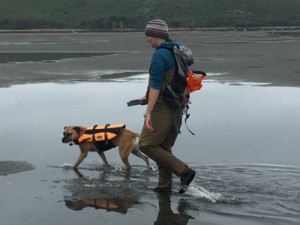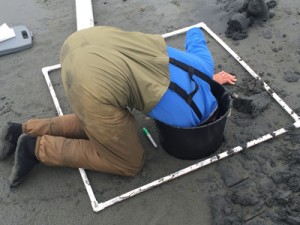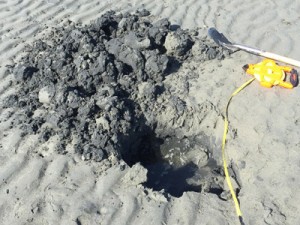A Day on the Flats
Chris Brunner, May 26, 2015
Clamming is a popular recreational sport year-round in Northern California, though the most popular periods are during the late spring and summer when the lowest tides of the year expose tidal flats for a few brief hours at a time. Dedicated clammers often plan their vacations around these tidal events, frequently bringing multiple generations of their family along to join in the messy work. There are very few bays in Northern California that can support the recreational harvest of large clams, such as gapers (Tresus sp.) and butter clams (Saxidomus sp.), two of these are Humboldt and Tomales Bays.

Melissa Partyka, with Lady Jane, conducting recreational clamming research, looking at vibrio communities.
These days, during a big low tide, you might just find Melissa Partyka and Ronny Bond walking the muddy tidal flats of Tomales Bay with their dog Lady Jane by their side, in search of clams. Melissa, a staff researcher and PhD candidate in the Graduate Group of Ecology, and Ronny, a water quality researcher and the field research manager, both in the Atwill Water and Foodborne Zoonotic Disease Laboratory, with the Western Institute for Food Safety and Security, are interested in studying communities of bacteria associated with the clams on these tidal flats. They are focusing on vibrios, a type of bacteria which have caused a growing number of illnesses over the last ten years, particularly from consumption of undercooked seafood. One of these bacteria, Vibrio vulnificus, has led to multiple instances of wound infection and amputation in the Gulf of Mexico, while another, V. parahaemolyticus, is the leading cause of gastroenteritis (stomach flu) from shellfish consumption. Melissa and Ronny are trying to quantify the exposure of recreational clammers to vibrios in the sediment during clamming activity. Exposure may cause illness through wound infection, ingestion of sediments during collection (people get covered in mud), and contamination of equipment and food preparation surfaces back home (or at the campsite).

Before any digging takes place, Melissa and Ronny determine the density of clams in a 1m-square area using a quadrant.
While there have been no reported cases of V. vulnificus infection in Northern California clammers, this bacterium has been isolated from intertidal flats in both Humboldt and Tomales Bays. V. parahaemolyticus is found much more frequently and was responsible for cases of foodborne illness in consumers of local oysters a few years back. Though this doesn’t mean that clammers need to be concerned, Melissa does suggest caution when out on the flats, “Like all things pulled from the mud, clams are covered in bacteria, which means clammers are covered in bacteria. It’s a good idea to wash your hands and equipment well before preparing your clams and to clean and dress any wounds you get when out digging.”

Sediment cores are taken before clams are excavated using typical clamming equipment. The hole that results is measured to approximate the amount of sediment being disturbed for a single clam.
Melissa knows from experience what a V. vulnifius infection feels like, a small barnacle cut on her pinky turned her finger into a sausage in a matter of days. “People with healthy immune systems shouldn’t have a problem” says Melissa, but young children and anyone with compromised health should keep a close watch on those cuts and seek out medical attention if swelling occurs.

